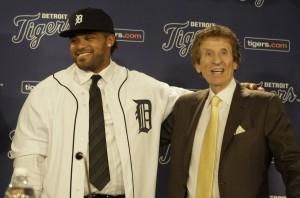No headline provided

February 3, 2012
In 1976, the Cleveland Indians signed starting pitcher WayneGarland for 10 years and $2.3 million. This deal came in the earlydays of free agency, when teams were exploring the best economicstrategies for employing top players. Garland, who had won 20 gamesthe previous year, never won more than six games in his stint inCleveland, and he was released after five years. The point is thatfew long-term deals have ever been deemed worth the long-termcommitment, because a good portion are never even completed. Firstbaseman Prince Fielder’s new deal is no exception.
Last week, the Detroit Tigers signed Fielder to a nine-year,$214 million deal. It is the second $200 million contract signedthis off-season – the other being Albert Pujols with the Angels -and the fourth in MLB history. For those who follow baseball,Fielder is big in every way imaginable. He hits mammoth home runs,hits in the clutch and happens to weigh 275 pounds. Prince Fielder,the son of former big-league slugger Cecil Fielder, made a splashin his first full season in 2006 with 28 home runs and 50 thefollowing season. From 2008-11, Fielder has never hit less than 32home runs per season and, since breaking into the major leagues,has never missed more than five games in one season. The three-timeAll-Star also sports a career .282 batting average, quiteimpressive for his power output and size. The odds indicate,however, that this deal won’t be worth it in the future.
Fielder is now in the American League, with the designatedhitter position available. The time may come when they may weardown and need time off defensively. The Tigers already have twofirst-base/designated hitter types in Victor Martinez and MiguelCabrera. Cabrera is arguably as fearsome a hitter as Pujols orFielder, however. Along with Fielder, the pair will be one of themost dangerous 1-2 punches to ever be seen in a lineup, comparableto Gehrig and Ruth, or Mantle and Maris.
The Tigers’ logic is that if Fielder and Cabrera hit to theirpotential on a yearly basis, then that will far outweigh thenegative aspect of the defensive headache the trio will pose downthe road for manager Jim Leyland.
The Tigers have committed an exorbitant sum to the two sluggers.Cabrera and Fielder, who are within a year in age, will have closeto $45 million committed to them until 2016, at which point Fielderwill be due $24 million a year until the deal expires in 2020 whenhe is 36 years old.
It is important to examine the elder Fielder’s career, as hesported a similar body type to his son while he was playing.Cecil’s best season came in 1990, when he hit 51 home runs as a 26year old, and the peak of his career spanned from 1990 until 1996,when he hit 39 home runs at age 33.
Coincidentally, age 33 is when Prince Fielder will first be onhis own without Cabrera, unless he re-signs with Detroit. It willbe interesting to see if Prince Fielder breaks down how his fatherdid, especially without another big bat next to him in thelineup.
Fielder is among the elite offensive producers of our era, butthe contract was absolutely a mistake. He is definitely worth the$20 plus million for the next four or five seasons, but as he growsolder, especially with his body type, he is almost bound to breakdown and become a financial liability for Detroit. Very fewlong-term, six-figure contacts have ever been played out tocompletion, let alone being viewed as a good deal: Only Derek Jeterand Todd Helton come to mind. Fielder is a tremendous player andhitter, but this contract will haunt the Detroit Tigers until itscompletion in 2020.






















Leave a Comment